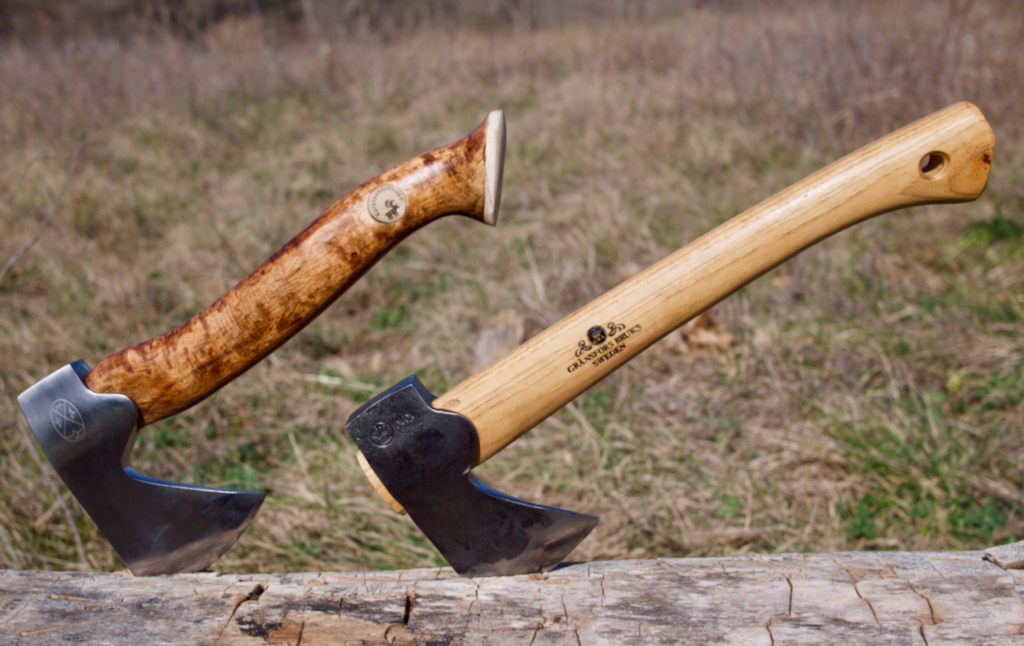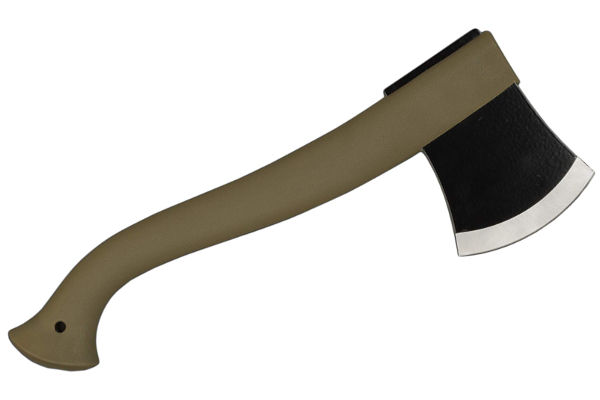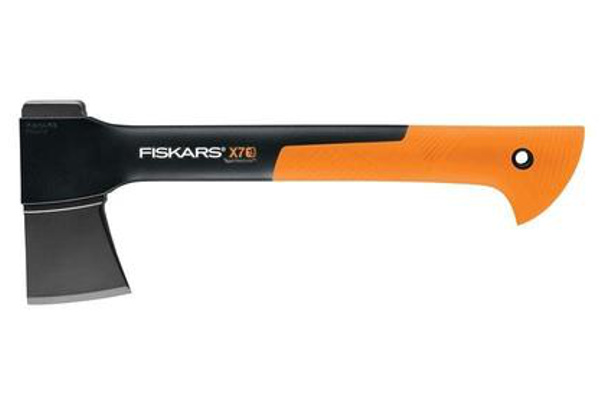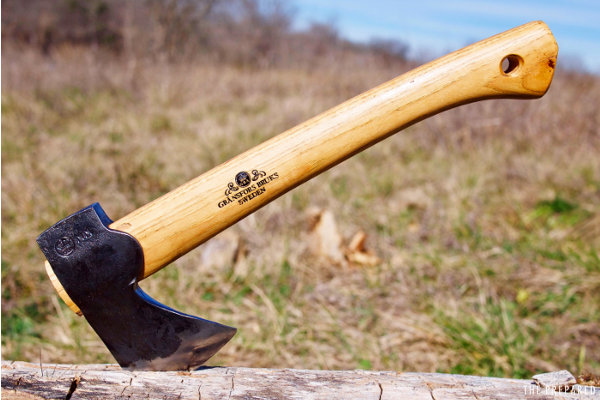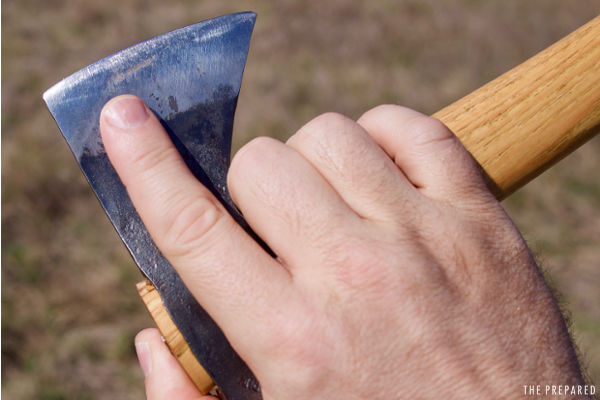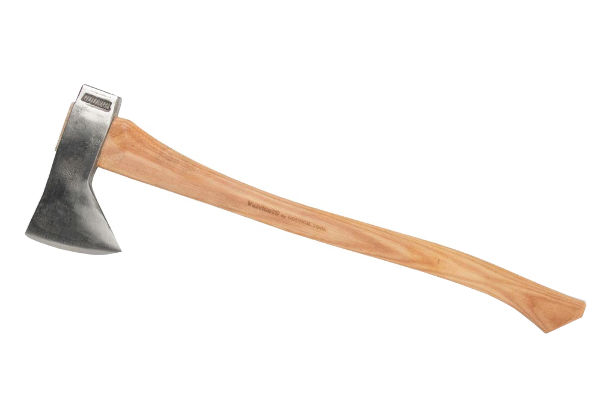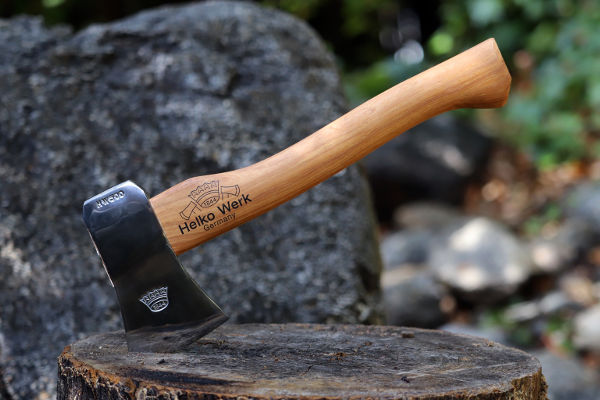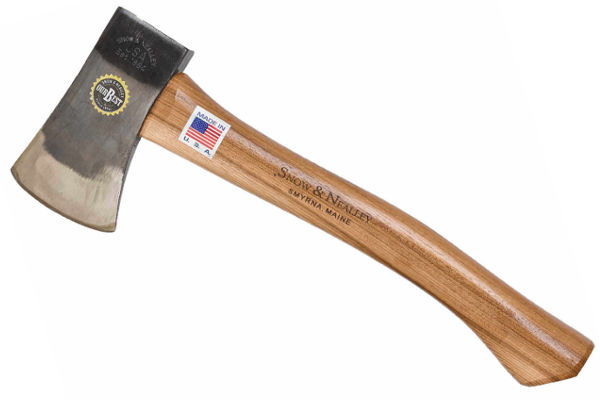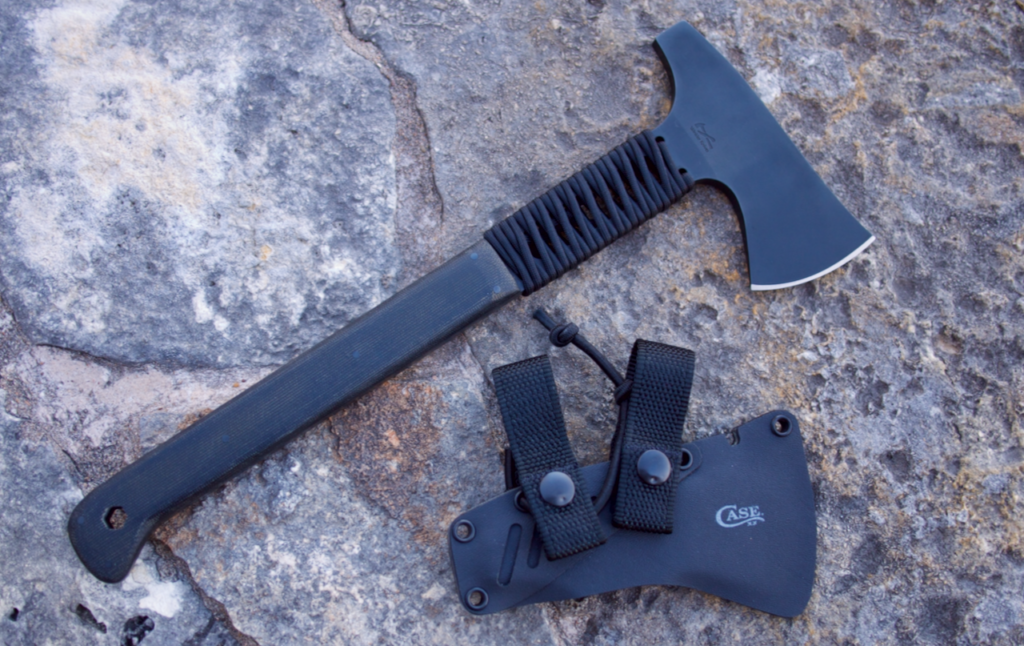From the early North American trappers and frontier folk down through the outdoor magazine and fiction writers of postwar era, the hatchet was the quintessential personal survival blade of the pre-Rambo generation. Before the “survival knife” craze swept the country in the 80’s, the hatchet was popularly regarded as the “one tool” you’d want for wilderness survival if you couldn’t have any other.
Much more than just an axe that’s scaled down for one-handed chopping, the hatchet works very well for tasks as diverse as fine carving, field dressing game, food preparation, firecraft, and shelter building. Indeed, apart from stabbing things to death, there is nothing an oversized survival knife can do that a hatchet can’t do better.
That’s why the modern bushcraft community overwhelmingly favors the combination of a small fixed-blade field knife and a hatchet or compact axe versus the “one knife” big blades popular with the tactical crowd.
The line separating small axes and hatchets gets blurry, to the point you may see some of the hatchets below labeled as axes.
More: If you’re not sure about the differences and which kind of tools make the most sense for you, check out the guide to picking and mixing bladed tools.
More: Best survival axe review
Full details of our best survival hatchet reviews, a table of competitors, and more below the fold.
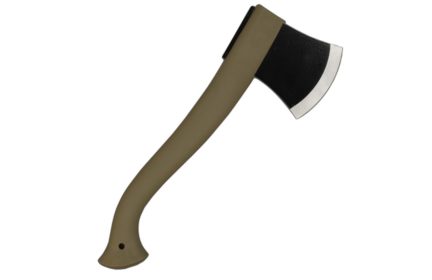
Best for most people:
Morakniv Camping Axe
The best hatchet for most preppers is the $60 Morakniv Camping Axe, a no-frills, lightweight, durable hatchet that can weather years of neglect under a bed or in a car’s trunk, and can comfortably ride for miles on your belt during an emergency. This small hatchet carries the famous Morakniv name and reputation for quality, causing it to stand head and shoulders over its more widely known competitors from “big box” retailer brands. Its modern, synthetic materials make it suitable for use and abuse everywhere from the city to the woods — but if the handle breaks after SHTF, you won’t be able to replace it the way you can with a wood-handled hatchet.
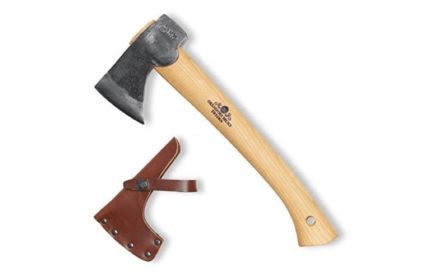
Upgrade pick:
Gransfors Bruks Wildlife Hatchet
The best all-around hatchet for wilderness survival is the award-winning $120 Gransfors Bruks Wildlife Hatchet. Our experts own and use this handmade, heirloom-quality tool, and it’s difficult to think of anything to criticize it for other than the inflated price (you always pay extra for the GB name). The beard is long enough that you can comfortably carve and do most other “knife” chores by choking up on the head, and the size and weight are just large enough to be truly effective in the bush but just small enough to ride well on the belt. This is a hatchet that you carry in place of a big, bulky field knife, and it’s often paired with a multitool or a thin-bladed knife for skinning, slicing, and batoning.
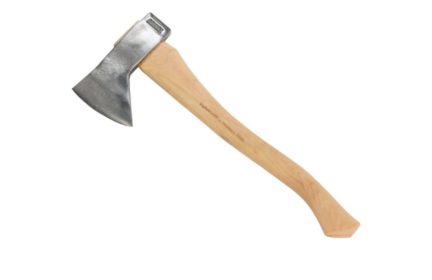
Council Tools Velvicut Hudson Bay 1.25#
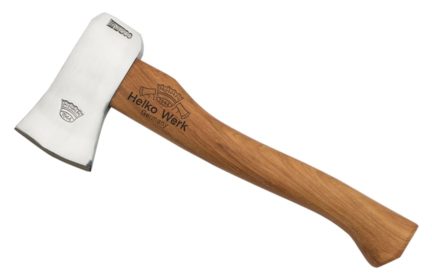
Helko Voyager Camp Hatchet
A step down in price but not necessarily quality is the $110 Council Tools Velvicut Hudson Bay 1.25#, a hatchet that’s about the same size, weight, and head shape as the Wildlife Hatchet but made in North Carolina out of 5160 high-carbon steel. These two tools are similar enough that the choice comes down the price, availability, and aesthetics. The Hudson Bay pattern came over from Europe in the early, pre-Revolutionary frontier days, and the Velvicut Hudson Bay is a premium example of this time-tested pattern.
The significantly cheaper $90 Helko Voyager Camp Hatchet comes in roughly the same size and weight class as the GB and Velvicut hatchets mentioned above, but with a head design that gives up some carving ability in exchange for better splitting ability. While the Wildlife Hatchet is a survival knife alternative, the Helko works better as a field knife companion, with the hatchet doing wood chopping and splitting and the knife doing everything else (carving, fuzz sticks, skinning game, etc.).
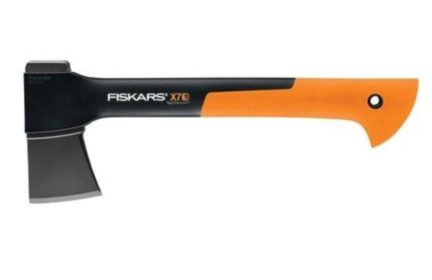
Under $25:
Fiskars X7 hatchet
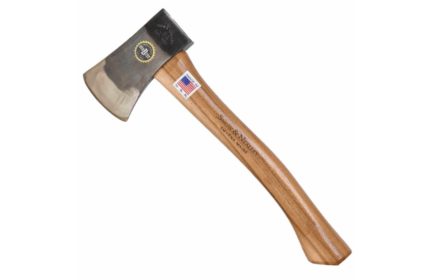
Under $50:
Snow & Nealley Outdoorsman’s Belt Axe
The best budget hatchet for preppers is undoubtedly the $25 Fiskars X7 hatchet. It’s a bit larger and heavier than the Morakniv Camping Axe, but it’s one of the most widely loved and well-reviewed pieces of prepper gear in the past decade. When the X7 first appeared on store shelves, preppers and bushcrafters assumed this cheap, plastic-handled hatchet with the mystery meat steel must be junk. But, over time, the glowing reviews started piling up in forums, YouTube videos, and Facebook posts, and now the little X7 has its own cult following and legion of imitators from other knife makers.
If you’re looking for a budget survival hatchet but prefer a wood handle for the comfort and repairability, we like the $50 Snow & Nealley Outdoorsman’s Belt Axe. This larger, heavier hatchet doesn’t match up to the fit, finish, and materials of competitors from premium makers, but it’s the only sub-$50 hatchet that gets anywhere in the same ballpark.
Finally, if money is no object and you want the most indestructible, well-designed survival hatchet in existence, then the $500 Case Winkler Pack Axe is the top of the heap. The Pack Axe is made by Winkler Knives and designed by Special Forces legend Kevin Holland — one of the few soldiers to have done tours in both the Navy SEALs and the army’s elite Delta Force, and the first SEAL to ever carry a Winkler tomahawk into service (he pioneered this particular trend back in the 90’s). For features, fit, finish, balance, and sheer legacy, you can’t top this survival tool.
Be prepared. Don’t be a victim.
Want more great content and giveaways? Sign up for The Prepared’s free newsletter and get the best prepping content straight to your inbox. 1-2 emails a month, 0% spam.
Why you should trust us
I’ve professionally reviewed bladed tools for 6 years, personally used them in the bush for 35 years, and have been a prepper for 10 years.
We’ve spent an additional 32 hours preparing this review by talking with other experts in the field, working with some of the products, and researching countless product reviews and social forum threads.
Hatchet basics and our criteria
Basic hatchet parts and names are in the axe review.
Ultimately, it’s hard to go wrong picking a survival hatchet right now if you stick to a few good makers, and it often comes down to aesthetics and budget. Thanks to the popular bushcraft scene in Europe and the US, the wilderness hatchet market is an embarrassment of riches.
Any of the premium hatchets in the Council Tools Wood-Craft and Velvicut lines, or the hatchets from famed European foundries like Gransfors Bruks, Hults Bruk/Hultafors, or Helko, will blow you away. The budget options from Council Tools, Snow & Nealley, and Condor Tool & Knife are also very good.
We consider tools under 16 inches long to be hatchets and those over 19 inches to be axes. There are a few great large hatchets (or compact axes) in the 17-19 inch range, but we generally encourage you to stay out of this in-between zone — if you want hatchet, go short, and if you want an axe, go longer. As always, though, “short” and “long” are relative to your body size, so for a 6’5” man an 18-inch hatchet might be the same effective “size” as a 11-inch hatchet is for a 5’2” woman.
Most hatchet manuals tell you to avoid hammering with a hatchet’s poll because doing so will change the shape of the eye and cause the handle to come loose. For most wood-handled hatchets, this is sound advice — the steel that’s in the poll and eye is softer than the steel at the edge, so hard impacts there will cause the eye to deform over time. But some hatchets are made to be hammered with, and have a hardened eye and poll for this purpose.
There are a number of all-metal “tactical” hatchets that we’ve included in our full list, but these tend to be very expensive. In general, only go the all-metal route if bombproof durability is your first priority, because you sacrifice quite a bit in terms of overall weight and weight distribution with this category of tools.
We avoid the “tacticool” hybrid units that are marketed as “a hatchet with extra stuff like wrenches and pry bars!” because they tend to be so diluted that they don’t do their core hatchet tasks well — making them more of a “Swiss Army Knife with a hatchet slapped on.”
The contenders
View the spreadsheet in Google Docs
Best for most: Morakniv Camping Axe
- Price: $$
- Specs: 12.6” length, 1.10 lbs weight, synthetic handle, Scandi grind edge
- Pros: indestructible, great brand reputation, widely available, inexpensive, Scandi grind edge is easy to maintain, quality leather mask included
- Cons: a convex edge is better on a hatchet, and if the handle breaks then it’s useless
Who should buy this: For preppers who aren’t looking to overly optimize this pick, and who just want a reliable, easy-to-maintain survival hatchet for their belt or pack, but are leery of synthetic-handled offerings from brands like Gerber, Fiskars, and SOG, the $60 Morakniv Camping Axe is your best bet.
Also, if you’ve learned how to sharpen a Scandi grind knife, then your sharpening kit and skills will translate directly from your knife to this Scandi grind axe.
Benefits: The Morakniv’s boron steel is tough and will hold an edge, and the Scandi grind makes the edge easy to maintain. That Scandi edge is also better than the standard convex hatchet edge for “big knife” tasks like carving wood and processing game, making this tool a great substitute for a larger field knife.
The overall design and steel are well suited for light hammering, since there is no eye to damage with these kinds of blows.
The curved handle is comfortable and ergonomic, and the plastic and epoxy material offers an unrivaled combination of strength and weight.
Downsides: There are some reports of the handle chipping around the head, which we totally believe because the plastic is going to end up striking wood periodically given the way the tool is designed. This is especially the case if you’re chopping at an angle, as you would when limbing a log or branch.
As is the case with all synthetic-handled tools, if this handle fails catastrophically, then your hatchet is useless.
The Scandi grind edge is less durable for impact blows than the traditional convex edge, so it will dull quicker and be less resistant to chipping.
Brand and product reputation: Through research and first-hand experience with Morakniv, we’re confident they’re a classic, time-tested brand that produces quality cutting tools. There is the inevitable online backlash against a brand that’s this popular with campers and bushcrafters, but you can ignore it. This particular product is one of the company’s more obscure offerings, but users tend to love it.
Best budget hatchet: Fiskars X7
- Price: $$
- Specs: 14” length, 1.4 lbs weight, hollow synthetic handle, V-grind edge
- Pros: Widely available, inexpensive, lightweight, handle can be used for storage, every effective chopper
- Cons: a convex edge is better on hatchet, and if the handle breaks then it’s useless, cheap plastic mask not made for a belt
Who should buy this: If you’re in the market for a simple, synthetic-handled survival hatchet, but the Mora listed here costs more than you wanted to spend on this prep, then the $25 Fiskars X7 hatchet is your next stop. Or, if you need a cheap second or third hatchet for a GHB, a companion’s BOB, or just something to practice with, then look no further.
Benefits: The main benefit of this hatchet is its insane value proposition — it’s rare we find a product under $25 that we feel is actually worth it.
The synthetic handle is hollow and can be used for storage.
Nobody knows what kind of steel is used on this product, but users report that it holds an edge well and sharpens relatively easily enough.
In the product testing we’ve reviewed, this axe cuts very well and stands up to hatchets many times its price. In fact, this hatchet cuts so well that it’s really painful for those of us who are into fine craftsmanship to see this unlovely, cheapo tool hang with the greats.
The main reason for the X7’s shockingly good cutting effectiveness is, surprisingly, found in its hollow plastic handle. The X7 carries more of its weight in is head than its solid-handled competitors in the same overall size and weight class, and that heavier head means more force per strike. In other words, unlike the competition, the X7’s handle weighs close to nothing, so it spends all of its weight budget on its head where it can do the most good.
When you combine the X7’s heavy head with its V-shaped edge and thin blade profile, you get a hatchet that bites deeper into the wood on each stroke than its convex-edged, lighter-headed competitors.
Downsides: The hollow handle is somewhere between wood and solid plastic on the durability scale, but it isn’t replaceable so the hatchet is junk if it breaks.
The V-grind edge isn’t as good for splitting as a convex edge, nor is it as long-lasting and chipping-resistant. It also isn’t as easy to resharpen as either convex or Scandi edges.
The cheap plastic mask it comes with isn’t designed for belt carry. Many people replace it.
Brand and product reputation: Fiskars is mainly known for their scissors and other cheap cutting tools, and they really don’t have the best reputation. Which is why the X7 is such a stand-out: somehow, some way, this little hatchet turned out to be magically great.
Best bushcraft hatchet: Gransfors Bruks Wildlife Hatchet
- Price: $$$
- Specs: 13.5” length, 1.3 lbs weight, hand-forged, convex edge, quality leather mask, hickory handle
- Pros: Lightweight, flawless design and execution, versatile, hard steel and high edge retention
- Cons: Price
Who should buy this: Grab the $120 Gransfors Bruks Wildlife Hatchet if you want to own the reigning champion or care about weight and versatility.
Benefits: This hatchet’s head, handle, and edge are all designed so that you can choke up on it for general-purpose cutting, carving, food and game preparation, and slicing chores. The Wildlife Hatchet can do much of what a good field knife can do, and do it better. (The obvious exceptions are prying, digging, batoning, and other tasks that only a knife can accomplish.)
The premium hickory handle is durable and comfortable, and the hand-forged head is hung on it without gaps or flaws. The overall balance is perfect, and feels a bit like magic in the hand.
The edge is hardened to about 57 RC — on the high end of what you’d want for an axe — resulting in superior edge retention.
Downsides: The main downside to this hatchet is the price.
Another possible downside is the higher hardness, which anecdotally can make the edge less resistant to chips. We don’t put much stock in the few chipping stories we’ve seen online, though, because it’s difficult to tell what’s the result of abuse and what’s the result of a quality control with a batch of steel or heads.
Brand and product reputation: One of our experts has used one of these hatchets for years and loves it, and in general this is one of the most popular and well-regarded products in the outdoors scene.
Council Tools Velvicut Hudson Bay 1.25#
- Price: $$$
- Specs: 14” length, 1.4 lbs weight, drop-forged head in 5160 steel, satin finish, convex edge, quality leather mask, hickory handle
- Pros: Lightweight, high-quality, versatile, premium knife steel that’s tough and chip-resistant
- Cons: Price, edge retention is less than with harder, more brittle steels
Who should buy this: The $110 Council Tools Velvicut Hudson Bay 1.25# hatchet is great for preppers who are looking for the American-made answer to the Swedish-made Wildlife Hatchet, or who want a slightly less expensive alternative that doesn’t sacrifice quality.
If you’re comfortable maintaining a convex edge, then you can get a bit more toughness over the Wildlife Hatchet in exchange for lower edge retention with this hatchet’s more ductile steel.
Benefits: The Velvicut’s high-carbon 5160 steel is popular with knifemakers for its combination of incredible toughness and ease of sharpening. If you manage to chip one of these hatchets, then you’ve either done something wrong (like chopping frozen wood with a cold axe head) or you’ve gotten a defective unit with a bad heat treatment.
The handle is premium hickory, and is comfortable to work with for extended periods of time.
As with the Wildlife Hatchet, this is designed as a premium bushcrafting tool that can be used in place of a field knife for many camp chores and wood carving tasks.
Downsides: Aesthetically, reviewers report that the Velvicut feels a bit less polished and premium than the Wildlife Hatchet. Its head is drop-forged (i.e. hammered by a machine and not with a hand-held hammer) and satin finished, so it looks more manufactured and less handmade.
The main trade off is that the steel is a bit on the softer side and will have to be touched up more often.
Brand and product reputation: Council Tool is a very well-regarded, top-tier axemaker. All of the products in their premium Velvicut line get widespread praise on forums and in reviews.
Helko Voyager Camp Hatchet
- Price: $$
- Specs: 13” length, 1.75 lbs weight, drop-forged head in C50 steel, polished finish, convex edge, quality leather mask, Swiss-made hickory handle
- Pros: Good at splitting, premium materials
- Cons: Price, a little on the heavier side
Who should buy this: For preppers with a larger, thicker field knife, the $90 Helko Voyager Camp Hatchet is ideal as a more wood-focused companion blade. With a head that works better for splitting than some of the more bushcraft-centric hatchets, the Helko is perfect for wood-processing chores in hardwood forests.
Benefits: As a premium-quality, European hatchet in the sub-$100 range, the Helko Voyager is the best value for a traditional wood-handled hatchet.
The highly polished head slides through wood and resists corrosion, and the hard blade takes and keeps a keen edge.
The thicker wooden handle provides a bit of extra grip for added comfort in long chopping sessions.
Downsides: This hatchet is a few ounces heavier than competitors of similar size, materials, and quality. If you’re optimizing for pack weight then this may not be the optimal fit.
As with the Velvicut hatchet, this drop-forged piece doesn’t have quite the same handcrafted aesthetics as competitors from Gransfors and Hults, but the linseed-oil-treated handle has a nicer finish than the raw wood handles on some competitors. This is also not necessarily a downside, since some folks may like the more machined feel of the head better than the more rustic feel of a hammer-forged head.
Brand and product reputation: Helko is a German axemaker that isn’t as widely known in the US as the two big Swedish makers, Gransfors Bruks and Hults Bruk. But Helko delivers a comparable level of quality. This particular hatchet has not been widely reviewed, but a version with a lighter head, the Pathfinder, has had more exposure, and the reviews are uniformly glowing.
Snow & Nealley Outdoorsman’s Belt Axe
- Price: $$
- Specs: 15.75” length, 2.25 lbs weight, head sourced from US steel and forged in the US, lacquered finish, convex edge, hickory handle
- Pros: Good at splitting, inexpensive
- Cons: Very heavy for a wood-handled hatchet
Who should buy this: The $50 Snow & Nealley Outdoorsman’s Belt Hatchet is ideal for budget-conscious preppers who are looking for a hatchet in the $50 range but prefer the features and aesthetics of a wood-handled design to the synthetic- and metal-handled offerings that dominate this price range.
Benefits: The right mix of low price and acceptable quality.
Downsides: This is one of the heaviest hatchets in this review, which makes it less packable. There are a host of excellent two-handed axes in this weight range, in fact, but none that are this inexpensive.
The edges that come on this maker’s products aren’t always the best, so if you want the most performance for your dollar then you should be prepared to do some sharpening. The handle is untreated, so plan to soak it in linseed oil and apply some butcher’s block conditioner.
Brand and product reputation: This American axemaker’s offerings have an outstanding mix of quality and features for the price, and this is their main hatchet product. Reviews of this particular model are scarce, but if you’re willing to do a bit of sharpening then these are generally well-regarded products.
Case Winkler Pack Axe
- Price: $$$$$
- Specs: 14.5” length, 1.6 lbs weight, 80CrV2, canvas Micarta handle
- Pros: Amazing quality, lightweight, indestructible
- Cons: Expensive. Not as good of a splitter as a more traditional design
Who should buy this: The $500.00 Case Winkler Pack Axe is for preppers who can afford to spend an insane amount to have this tool’s unmatched combination of storied American brand names, military pedigree, and total doomsday indestructibility. From wilderness survival to urban demolition, this thing can do it all.
Benefits: The relatively low weight of this tool makes it very packable, and the one-piece steel construction means it’ll never fail. The canvas laminate handles are comfortable. The balance and feel are extraordinary. There’s a nice length of spare paracord wrapped around the top, just in case you need it. A subtle upwards curve in the top of the head makes it work well for a knife substitute for carving.
Downsides: This axe has two downsides, the first of which is the price. You’re buying an heirloom quality, battle-tested tool that’s made in the USA in limited quantities, and the cost reflects that.
The second downside isn’t really a downside, depending on how you plan to use it: the thinner edge has a lot of bite, which makes it great for chopping but less ideal for splitting. You can definitely split kindling with it, but it’s more optimized for chopping, cutting, carving, and general camp chores.
Brand and product reputation: W.R. Case is a legendary American knife brand, and they partnered with ABS Master Bladesmith Daniel Winkler for this project. Winkler’s knives and tactical tomahawks are famous for being carried by elite Special Forces units in the field, used as tools and as weapons. Kevin Holland was the Navy SEAL who commissioned the very first such tactical ‘hawk from Winkler back in the 90’s, and he carried these tools and iterated their designs with Winkler during his tours as a SEAL and in Delta Force. The Pack Axe reflects all that knowlege and hard-won experience.
Other hatchet reviews
Hults Bruk Almike ($135): Hults Bruk’s answer to the Gransfors Bruk Wildlife Hatchet is realistically as good as its competitors, even if it doesn’t quite enjoy the same exalted status among bushcrafters.
Gransfors Bruks Small Hatchet ($155): Lighter and more compact than the Wildlife Hatchet, pick this if you’re optimizing for portability. But prepare to pay the full GB markup on this rarer, boutique item.
Gransfors Bruks Outdoor Axe ($200): A slightly lighter, slightly longer, significantly more expensive alternative to the Wildlife Hatchet, the Outdoor Axe also has a metal collar on it to help with durability in the case of overstrike. In terms of features and capability, we consider this axe an upgrade to the Wildlife Hatchet.
Buck 106 Compadre ($120): The Compadre is a premium, totally indestructible, all-metal camp hatchet with 5160 steel, a Cerakote finish, and a canvas micarta handle. If you want to dip into the world of up-market, all-metal tactical hatchets without breaking the bank on a Winkler or a Medford, this is a great option. It’s short, and much of the weight is in the handle, so don’t expect its chopping abilities to match our main picks.
TOPS Grandpa’s Axe ($140): Another “tactical”-type hatchet, with a lower-quality but more corrosion-resistant steel (1095) than the Buck Compadre. Handle is also canvas micarta, and features and performance should be comparable.
Council Tool Camp Carver ($140): A brand new entry into the world of bushcraft hatchets, the Camp Carver is specially designed by and for the modern, YouTube- and forum-driven bushcraft movement. It features a large, V-shaped edge grind that’s practically a Scandi, which makes it great for cutting and carving. The poll and eyewall are hardened in order to make it suitable for secondary use as a hammer, and the head shape is designed for fine carving work in the choked-up position. This product is very much intended to not just match but totally dominate any of the Gransfors offerings, but it’s too new to really judge how well it lives up to that goal. The only real complaint about this hatchet (so far) is the grind — many would prefer a more traditional convex edge.
Estwing Camper’s Axe ($35): This is the highest-value all-metal budget hatchet option in this guide. The steel is relatively soft, so edge-holding ability is minimal, but it’s very tough and a capable chopper. You pay for all that toughness with extra weight, though, as this hatchet weighs more than some full-sized axes.
CRKT Freyr ($55): This bearded, Norse-style design is partially optimized for throwing, but it works fine for chopping and carving. We’ve included it mainly as a much more lightweight alternative to our budget pick, the Snow & Nealley hatchet. We’ve handled this axe in person and the quality appears decent. Most of the reviews are positive, but there’s at least one strongly negative YouTube review of it that we’re not at all convinced is unbiased. If you like the aesthetic and the price range, then go for it.
Condor Tool & Knife Greenland Hatchet ($70): This is a large, traditional hatchet from a solid budget knifemaker. The steel isn’t exactly premium, but the reviews of this hatchet are very strong and we consider it a top budget contender.
H&B Belt Axe ($130): H&B Forge is a boutique American maker of tomahawks and hatchets for historical reenactors, but its products are real, premium, hard-use tools that just happen to be historically accurate. They also come with a lifetime guarantee. We love the looks of this hatchet, and so if you’re shopping in the upper tier of this guide and want something unique, this is a great option.
Mueller Biber Classic Hatchet ($100): An Austrian maker of fully hand-forged axes, Mueller’s classic hatchet is easily up there with products from Helko and the other top-tier makers, and the price is definitely right. This is yet another one to consider if you want get quality without paying a markup for a name, and you want something different than the standard list of Swedish and American premium names.
Medford Bearded Hawk ($425): This is billed as a “tomahawk,” but it’s an ultra-premium wonder of modern technology in hatchet form, and with a price to match. The S7 steel is the current hotness in shock-resistant, high-carbon metallurgy, and the PVD coating adds very durable corrosion protection. This is only for preppers who want to go full-operator, whatever the cost.
Winkler Camp Axe ($525): Like the Medford hatchet, this is a hard-use, combat-tested tool that sits at the very top of the “operator” pyramid. This small axe and its siblings in the Winkler line are used by elite military units the world over for breaching, survival, and even killing. It’s a good bit lighter than the Medford Bearded Hawk, despite a few extra inches of length. The 80CrV2 steel isn’t quite as shock-resistant as S7, but you’re just not realistically going to break this.
Silky ONO ($90): Silky is a quality Japanese edged tool maker best known for their Gomboy line of folding saws. Their ONO is a very well-reviewed all-metal hatchet in the sub-$100 range, and is very lightweight for an all-metal design. Of all the hatchets in this guide, the ONO may have the best mix of low weight and high durability, so it deserves a close look from anyone who’s optimizing for pack weight.
Swiss Military Surplus Hatchet ($27) These cheap hatchets are showing up all over the internet, and the reviews are surprisingly good given the rock-bottom price. With a bit of finishing work, this hatchet might well stand up to our main budget pick, but for substantially less money.
